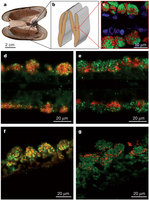摘要:深海热液喷孔中的所有生物都依靠从海床喷出的热液所提供的“地下燃料”(geofuel)来生存。在这些燃料中,过去只有两种已知为“化学合成共生初级生产”提供能量,它们分别是能氧化硫的共生体所利用的被还原的硫化合物和能氧化甲烷的共生体所利用的甲烷。现在,氢也被添加到了这个清单上。来自“中大西洋海岭”热液喷孔的Bathymodiolus贻贝,被发现与能够将氢用于初级生产的微生物共生体相关。对氢的氧化来说的一个关键基因存在于其他热液喷孔动物的共生体中,如管虫(亦称多毛虫)Riftia pachyptila 和盲虾Rimicaris exoculata,说明氢在其他共生体系中可能也是一个重要能量来源。
生物探索推荐英文论文摘要:
Nature 476, 176–180 (11 August 2011)
Doi:10.1038/nature10325
Hydrogen is an energy source for hydrothermal vent symbioses
Abstract: The discovery of deep-sea hydrothermal vents in 1977 revolutionized our understanding of the energy sources that fuel primary productivity on Earth. Hydrothermal vent ecosystems are dominated by animals that live in symbiosis with chemosynthetic bacteria. So far, only two energy sources have been shown to power chemosynthetic symbioses: reduced sulphur compounds and methane. Using metagenome sequencing, single-gene fluorescence in situ hybridization, immunohistochemistry, shipboard incubations and in situ mass spectrometry, we show here that the symbionts of the hydrothermal vent mussel Bathymodiolus from the Mid-Atlantic Ridge use hydrogen to power primary production. In addition, we show that the symbionts of Bathymodiolus mussels from Pacific vents have hupL, the key gene for hydrogen oxidation. Furthermore, the symbionts of other vent animals such as the tubeworm Riftia pachyptila and the shrimp Rimicaris exoculata also have hupL. We propose that the ability to use hydrogen as an energy source is widespread in hydrothermal vent symbioses, particularly at sites where hydrogen is abundant.

Figure 1: Hydrogen consumption in Bathymodiolus gills.

Figure 2: The sulphur-oxidizing symbiont has the gene for hydrogen uptake, which it expresses.

Figure 3: Hydrogen is consumed in mussel beds of B. puteoserpentis.







